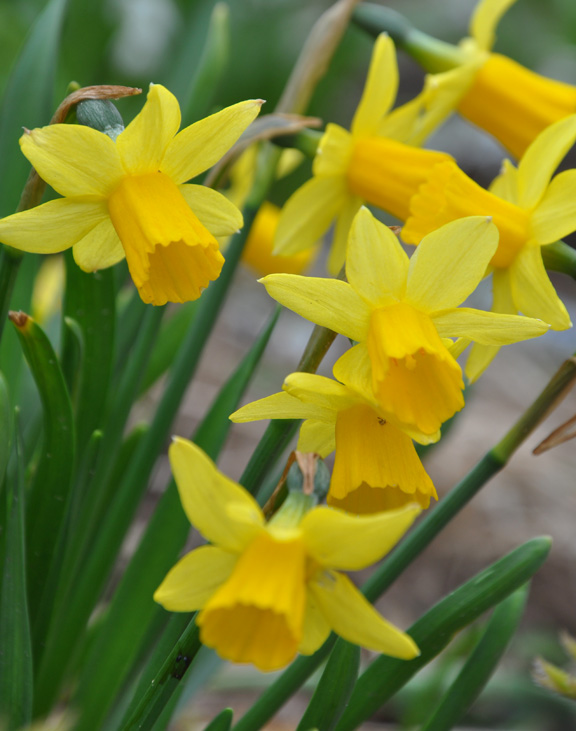
Though warm weather seems to have arrived early here in Southern Ontario, I remind myself that we are only entering the second half of April. Not two years ago we had a snowstorm in the third week of the month.
This spring we had really pleasant weather up until the end of March when strong gusts and a sudden dip in temperatures made working outside rather unpleasant. At night, the thermometer dipped below zero degrees Celsius. Though it's warmed up once again there is no predicting that the fine spring weather will last.
Over the last couple of years, I've been experimenting with options that can handle the blustery weather we sometimes have in April. I've discovered that there are a few tricks that winter-weary Canadian gardeners can put to good use.


The daffodils with flower buds in the second week of April.
For guidance as to what to plant, I look to my garden for clues. If the hyacinths and daffodils have flower buds in amongst a good few inches of green growth, it tells me it's safe to think about using pots of forced daffodil and hyacinth bulbs to fill my empty flower pots.
Generally speaking in the month of April, it's usually a bit early to think about using forced pots of tulips in my container plantings. Again, if I look to my garden, the growth of the tulips is always well behind that of the daffodils. If the vast majority of tulips aren't showing more than a couple of inches of green growth, that tells me it's better to hold off for a week or maybe two before I think about putting pots of blooming tulips outdoors. This year spring is exceptionally mild and I think gardeners in my zone might easily get away with using pots of forced tulips outdoors.

When the month of April proves to be a really cold one, I like to shop for pots of forced bulbs that have tight flower buds that are just beginning to peek up over short green foliage. If the weather remains cold, the bulbs slow down and hold back their flowers. Even though the arrival of fully open blooms may slow, the forced bulbs will still be a little ahead of the regular bulbs planted in the garden.
And as well as being the safest choice, less developed flowers will last a little bit longer than flowers that are already at their peak.
Here's a step by step:
•When I get my pots of forced bulbs home, I check to make sure they are well-watered (so often I find plants at the grocery store are as dry as can be). Next, I ease my bulbs into the cold by putting the pots outside during the day.
• For the first few nights, I bring the flowerpots onto our enclosed porch each evening (as an alternative, you could also place them in an unheated garage or even in the trunk of a car. Just be sure to remember they're in the back of your car before you head out!)
• If it's super cold (below zero Celsius), I might even bring the bulbs inside for the night or cover them (horticultural fleece or even an old sheet will do).

• Once my pots of bulbs have acclimatized to outdoor temperatures, I plant them up. This can be done in a couple of ways. You can sink the bulbs, pot and all, right into your container planting. This makes it easier to lift them out once they've finished flowering.

Alternatively, you can remove the plastic pot and plant the bulbs directly into your container planting Don't worry about teasing out the roots. Leave them as they are unless you want to break up the bulbs and plant them individually.

Companions for Forced Bulbs
Cheerful pansies are one of the first annuals to arrive at garden centres. They're pretty affordable and can handle cold temperatures like troopers. If I can find them, I prefer flats of smaller plants because they are the most economical.

Other annual options you might consider could be primula, alyssum and ranunculus. Ranunculus may object if the temperature gets really cold, so you might want to cover them if the weather changes for the worse.

Placing three or five Pussy Willow branches in the centre of my arrangements is my favourite way to add some height to my spring containers. Other options might be Red or Yellow-twig Dogwood or Curly Willow branches.
Other Ways to Use Forced Bulbs
Last fall we were so busy with interior renovations and garden projects, there was little time to plant spring bulbs. If like me, you didn't get around to planting bulbs in the fall, there is still something you can do.













